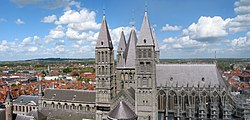| Our Lady of Tournai Notre-Dame de Tournai Onze-Lieve-Vrouw van Doornik | |
|---|---|
 View of the five Romanesque towers of the Cathedral of Tournai (12th century) | |
| Religion | |
| Affiliation | Roman Catholic |
| Diocese | Diocese of Tournai |
| Ecclesiastical or organizational status | Cathedral |
| Leadership | Bishop Guy Harpigny |
| Location | |
| Location | Tournai, Hainaut, Belgium |
 Interactive map of Our Lady of Tournai Notre-Dame de Tournai Onze-Lieve-Vrouw van Doornik | |
| Coordinates | 50°36′23.58″N3°23′19.89″E / 50.6065500°N 3.3888583°E |
| Architecture | |
| Architects | Building: unknown [1] Sacristy: G. Hersecap [1] Holy Spirit chapel: Simon Vollant [1] |
| Type | Church |
| Style | Romanesque, Gothic, French Baroque |
| Groundbreaking | Nave: 1140 and 1171 [2] Transepts: 1199–1213 [1] Transept vaults: 1243–1255 [1] Gothic choir: 1243–1255 [1] Sacristy: 1676 [1] Holy Spirit chapel: 1680 [1] [3] |
| Completed | 1700 [1] |
| Specifications | |
| Direction of façade | NW |
| Length | 134 metres (440 ft) |
| Width | 60 metres (200 ft) |
| Width (nave) | 20 metres (66 ft) |
| Height (max) | 83 metres (272 ft) |
| Spire | 5 (7 planned) |
| Spire height | 83 metres (272 ft) |
| Official name: Notre-Dame Cathedral in Tournai | |
| Type | Cultural |
| Criteria | ii, iv |
| Designated | 2000 [4] |
| Reference no. | 1009 |
| State Party | |
| Region | Europe and North America |
| Session | 24th |
| Website | |
| www | |
The Cathedral of Our Lady (French : Notre-Dame de Tournai; Dutch : Onze-Lieve-Vrouw van Doornik), or Tournai Cathedral, is a Roman Catholic cathedral, see of the Diocese of Tournai in Tournai, Belgium. It has been classified both as a Wallonia major heritage site since 1936 [5] and as a World Heritage Site since 2000.











